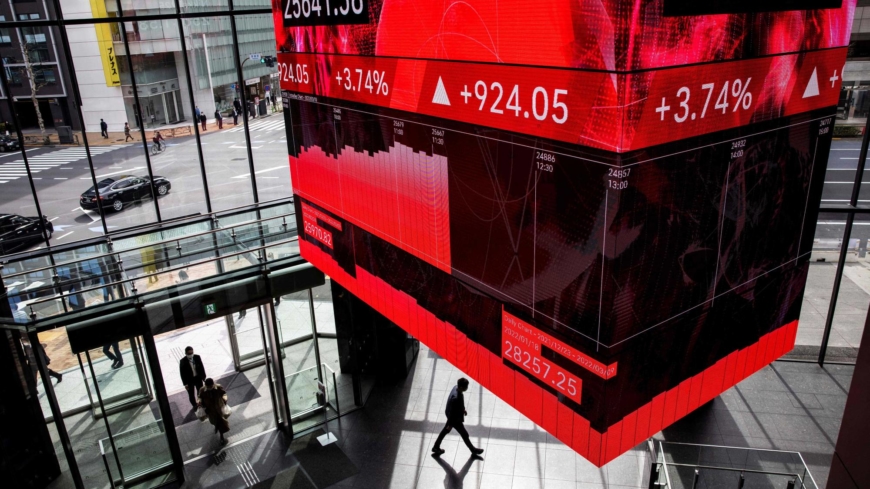President Donald Trump has positioned his economic agenda around the idea of an unprecedented $21 trillion investment boom—a sweeping promise that America is on the brink of a historic capital influx. Central to his narrative is the claim that corporations, sovereign wealth funds, and global investors are lining up to pour trillions into U.S. manufacturing, technology, defense, energy, and infrastructure.
However, a detailed analysis by Bloomberg Economics has sharply challenged this narrative. Their research shows that the true scale of actual investment commitments is much smaller—closer to $7 trillion, with even that figure subject to significant uncertainty. The gap between the rhetoric and the reality raises serious questions about feasibility, credibility, and the future of America’s economic trajectory.
This discrepancy reveals more than a simple exaggeration. It exposes structural challenges in global investment flows, illustrates the limits of “mega-project politics,” and highlights the complex economic environment that any administration—Trump’s or otherwise—must navigate in the years ahead.
The Origin of the $21 Trillion Claim
Trump’s figure is drawn from a combination of:
- public announcements by major corporations,
- preliminary memorandums of understanding with foreign investors,
- speculative projections tied to industrial policy,
- and ambitious assumptions about reshoring, reindustrialization, and AI-driven growth.
The administration frames these numbers as evidence of investor confidence and America’s renewed global appeal. In speeches, Trump has pointed to multi-billion-dollar deals from Saudi Arabia, the UAE, Japan, and other major players as signals of massive capital inflows on the horizon.
But Bloomberg Economics argues that the math behind the rhetoric is deeply flawed. Many announcements represent aspirational goals, press-release politics, or non-binding commitments rather than concrete investments.
Bloomberg’s Breakdown: Commitments vs. Reality
Bloomberg Economics’ analysis reveals three critical issues behind the inflated $21 trillion figure:
1. Only a Fraction Represents Confirmed Investments
Of the supposed $21 trillion:
- a large portion consists of non-binding agreements,
- many projects depend on political stability, regulatory approvals, and subsidy negotiations,
- and several are either delayed or unlikely to materialize.
Bloomberg’s more conservative—and more realistic—estimate of $7 trillion reflects actual announced investments, firm project timelines, and signed commitments.
2. Many Commitments Are Double-Counted or Overstated
Investment announcements often include:
- the lifetime projected value of projects rather than up-front spending,
- overlapping sectors counted multiple times,
- hypothetical expansions of existing facilities,
- and contingent financing that may never be secured.
These inflated calculations exaggerate the scale of economic revival.
3. Several High-Profile Deals Are Now Uncertain
Bloomberg highlights that numerous marquee commitments are at risk due to:
- geopolitical tensions,
- changing economic conditions,
- rising interest rates,
- supply-chain constraints,
- or shifting priorities of foreign investors.
Some of the most touted investments—especially from Middle Eastern sovereign funds and Asian conglomerates—are now undergoing internal review or re-evaluation.
Why the $21 Trillion Narrative Spread So Easily
The idea of a colossal investment influx resonates because it taps into several powerful themes in American politics:
A. Economic Patriotism and Reindustrialization
Promises of tens of trillions reinforce the belief that the U.S. is returning to its manufacturing dominance.
B. Foreign Capital as a Political Trophy
Large foreign deals symbolize international recognition and support.
C. Public Desire for Renewal
Americans, fatigued by decades of outsourced jobs, welcome any sign of economic resurgence.
D. Political Branding
Mega-numbers feed into the narrative of a transformative, high-impact presidency.
In this sense, the $21 trillion figure functions as a political symbol rather than an economic fact.
The Realistic Scale of America’s Investment Boom
While the $21 trillion claim may be exaggerated, it does not mean there is no investment boom. Bloomberg’s verified estimate of approximately $7 trillion still represents one of the most substantial capital commitments in decades.
This includes major investments in:
- semiconductor manufacturing,
- clean energy infrastructure,
- electric vehicle supply chains,
- AI and cloud data centers,
- domestic defense production,
- and logistics modernization.
Even at $7 trillion, this wave has the potential to reshape American industry and create significant economic transformation.
But the key distinction is that $7 trillion is transformative, while $21 trillion is utopian.
Why Investment Projects Are at Risk
Several structural challenges threaten the long-term viability of these commitments:
1. High Interest Rates
Expensive financing has already forced delays and cancellations in advanced manufacturing and clean energy projects.
2. Global Capital Competition
Countries such as India, Vietnam, Poland, and Saudi Arabia are offering aggressive incentives that rival U.S. subsidy programs.
3. Political Uncertainty
Changes in policy priorities between administrations can stall or reverse major projects.
4. Supply Chain and Labor Shortages
Semiconductor fabs, for example, face shortages of skilled workers, specialized materials, and construction capacity.
5. Geopolitical Risks
Tensions with China, Middle Eastern instability, and shifts in global trade could undermine foreign investor appetite.
Assessing the Economic Significance
Even if the actual figure is closer to $7 trillion, this represents:
- continued reshoring of strategic industries,
- growing interest in U.S.-based production,
- expanding AI and technology infrastructure,
- and renewed confidence in America’s long-term economic potential.
Yet the gap between $21 trillion and $7 trillion matters because it shapes expectations, policy planning, and public trust.
The Importance of Accurate Numbers
The exaggeration of investment figures can have several negative effects:
1. Misguided Policy Design
Inflated expectations may lead to mismatched subsidies, unrealistic budgeting, and flawed industrial strategies.
2. Investor Confusion
Global investors rely on accurate data; exaggerated claims may undermine credibility.
3. Public Misinformation
When political narratives diverge sharply from economic reality, public trust erodes.
4. International Misinterpretation
Foreign governments may misjudge U.S. economic conditions based on inflated rhetoric.
Accurate accounting is essential for effective policymaking.
Conclusion: A Boom, but Not a Super-Boom
The truth behind Trump’s $21 trillion investment narrative is a mix of ambition, exaggeration, and genuine economic momentum. While Bloomberg Economics reveals the real figure to be closer to $7 trillion, this remains a substantial and potentially transformative investment wave—just not the unprecedented economic explosion suggested by political messaging.
In the end, the debate over the numbers reflects a larger story: the United States is indeed entering a new phase of industrial renewal, technological expansion, and strategic investment. But the magnitude of this transformation must be understood through realistic and transparent analysis, not political hyperbole. Only then can the nation properly plan for the opportunities—and challenges—of the decade ahead.










